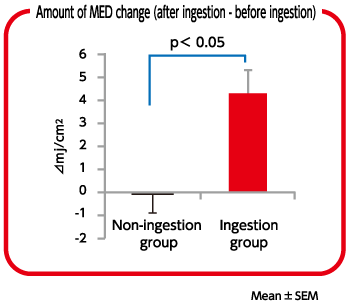|
Top page > Forefront of lactic acid bacteria research > Information on yogurt containing collagen peptides and milk ceramides > Improved skin resistance to ultraviolet radiation
Improved skin resistance to ultraviolet radiationUltraviolet-induced skin disorder and countermeasuresErythema, which is redness of the skin caused by ultraviolet radiation, is an early condition that could lead to various other skin disorders. If you are continuously exposed to ultraviolet radiation over the years, a chronic disorder called photoaging will manifest symptoms as you age, which include dark spots, wrinkles, and loose skin. They may also develop into benign tumors or precancerous conditions, and then into malignant tumors (cancer) in the worse case. When you hear the term “ultraviolet,” you might associate it with summer. However, we are actually exposed to ultraviolet light from the sky all year round, which may cause erythema. To protect yourself from ultraviolet radiation, it is important to reduce your exposure to ultraviolet light to the necessary minimum. Using a parasol, hat, long-sleeved clothes, and other garments that cover up the body is effective for achieving this. In addition to these external measures, internal measures to address the risk of ultraviolent radiation have been introduced in recent years, which involve consuming certain foods to protect our bodies against ultraviolet radiation from within. Yogurt containing collage peptides and milk ceramides improves the skin’s resistance to ultraviolet light.In a study where the subjects were fed yogurt containing collagen peptides and milk ceramides for five weeks, their minimal erythema dose (MED), which is an indicator of the skin’s resistance to ultraviolet light, increased significantly, while the redness and pigmentation of the skin after exposure to ultraviolet radiation were suppressed. This suggests that continuous ingestion of yogurt containing collagen peptides and milk ceramides could suppress the accumulation of damage caused by daily exposure to ultraviolet light and might prevent photoaging over the long term. 1. Minimal erythema dose (MED), an indicator of the skin’s resistance to ultraviolet light, increased.
*Figure created based on documents distributed at a seminar titled Threat of Ultraviolet Light in Modern Times and Latest Countermeasures, held in April 2016. 2. Redness of the skin (erythema) was suppressed.
*Figure created based on documents distributed at a seminar titled Threat of Ultraviolet Light in Modern Times and Latest Countermeasures, held in April 2016. 3. Pigmentation was suppressed.
*Figure created based on documents distributed at a seminar titled Threat of Ultraviolet Light in Modern Times and Latest Countermeasures, held in April 2016.
|
||||||||||||||||||






